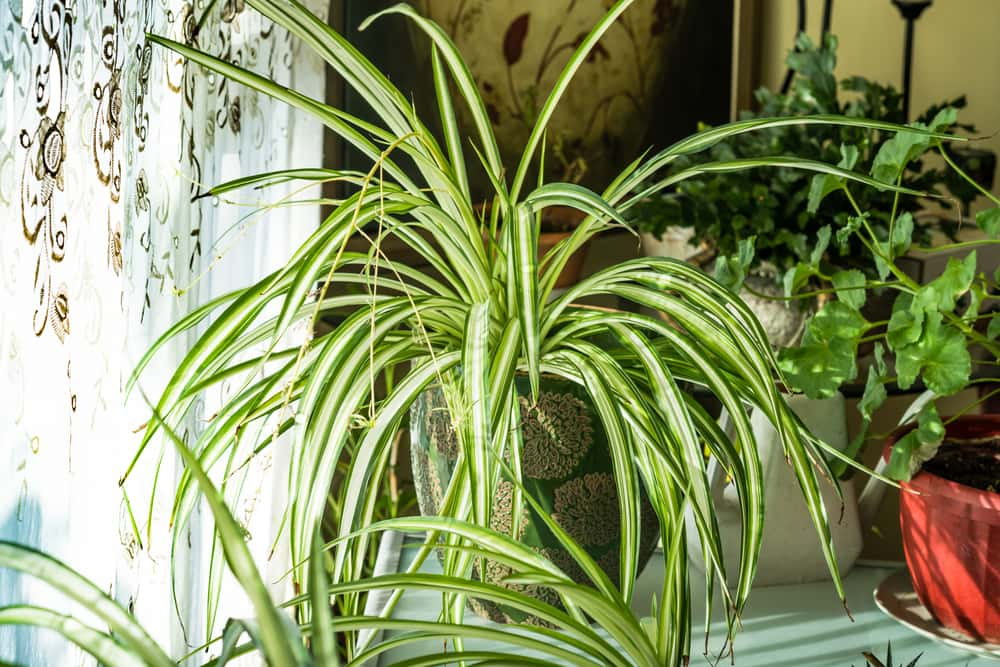
Spider plants, with their gracefully arching foliage and easy-care nature, have long been cherished as popular houseplants. However, amidst the vast array of greenery adorning homes and gardens, it’s not uncommon to encounter plants that bear a striking resemblance to spider plants but are, in fact, distinct species. In this article, we explore the nuances of plants resembling the iconic spider plant, delving into their unique characteristics and how to differentiate them from the true Chlorophytum comosum.
Characteristics of Spider Plants
A. Physical Features Spider plants are characterized by long, slender leaves that taper to a point, resembling the legs of a spider. These leaves typically display a central stripe of green bordered by creamy-white margins, lending a distinctive variegated appearance to the foliage.
The plant produces cascading clusters of small, white flowers on long, wiry stems, which eventually give rise to miniature plantlets or “spiderettes” at the ends of arching stems.
B. Growth Habits Spider plants are renowned for their vigorous growth habit, readily sending out runners or stolons that produce new plantlets at regular intervals. This proliferation of offsets contributes to their popularity as hanging or trailing plants, cascading gracefully from containers or hanging baskets.
Under favorable conditions, spider plants can grow quite prolifically, filling out their containers with lush foliage and trailing stems.
C. Propagation Methods Propagating spider plants is a straightforward process, primarily accomplished through division of plantlets or rooting of stem cuttings. Plantlets, or spiderettes, can be carefully detached from the parent plant and potted individually once they have developed sufficient roots.
Stem cuttings taken from mature plants can also be rooted in water or a well-draining potting mix to establish new plants, with roots typically forming within a few weeks under optimal conditions.
Similar Plants Mistaken for Spider Plants
A. Chlorophytum comosum variegatum Often referred to as the “variegated spider plant,” Chlorophytum comosum variegatum closely resembles the classic spider plant in appearance. It features long, arching leaves with a central stripe of green bordered by creamy-white margins, akin to the traditional variegation pattern of spider plants.
However, upon closer inspection, the foliage of Chlorophytum comosum variegatum may exhibit subtle differences in leaf shape or variegation intensity compared to true spider plants.
B. Chlorophytum laxum Chlorophytum laxum, commonly known as the “Malaysian spider plant,” shares similarities with spider plants in terms of leaf shape and growth habit. Its elongated leaves taper to a point and may display variegation patterns resembling those of spider plants.
Despite these resemblances, Chlorophytum laxum tends to have a more compact growth habit and may produce fewer offsets or plantlets compared to true spider plants.
C. Chlorophytum saundersiae Chlorophytum saundersiae, or the “ribbon plant,” is another species within the genus Chlorophytum that bears resemblance to spider plants. Its narrow, strap-like leaves may feature variegated patterns similar to those of spider plants, with central stripes of green and margins of contrasting color.
However, Chlorophytum saundersiae typically exhibits a more upright growth habit compared to the cascading form of spider plants, making it distinguishable upon closer observation.
How to Differentiate Between Spider Plants and Similar Species
A. Leaf Morphology Pay close attention to the shape and size of the leaves, noting any deviations from the characteristic tapered, arching foliage of spider plants. Look for differences in leaf width, length, and variegation patterns that may distinguish similar species from true spider plants.
Examine the arrangement of leaves along the stems, as well as the overall growth habit of the plant, which can vary between species within the genus Chlorophytum.
B. Flower Structure While the flowers of Chlorophytum species may share similarities in terms of color and size, subtle differences in flower structure can help differentiate between species. Note the arrangement of flowers on the inflorescence, as well as any distinctive features such as petal shape or arrangement of reproductive organs.
Spider plants produce characteristic clusters of small, star-shaped flowers on long, slender stems, which eventually give rise to plantlets at the tips of flowering stems.
C. Growth Patterns Consider the overall growth habit and behavior of the plant, including its propensity for producing offsets or runners. Spider plants are renowned for their prolific production of plantlets along trailing stems, whereas similar species may exhibit different growth patterns or reproductive strategies.
Observe how the plant responds to environmental conditions and care practices, as spider plants have distinct growth requirements and responses that may differ from those of similar species.
Conclusion
A. Recap of Key Points In summary, while plants resembling spider plants may share certain visual characteristics, it’s essential to carefully observe key features such as leaf morphology, flower structure, and growth patterns to accurately identify them. Varieties within the genus Chlorophytum, such as Chlorophytum comosum variegatum, Chlorophytum laxum, and Chlorophytum saundersiae, may closely resemble spider plants but exhibit subtle differences upon closer inspection.
B. Importance of Accurate Plant Identification Accurate plant identification is crucial for providing appropriate care and ensuring the well-being of indoor and outdoor greenery. By familiarizing oneself with the unique characteristics of different plant species, gardeners can better meet their needs and address any issues that may arise.
C. Encouragement for Further Exploration of Plant Diversity Embrace the diversity of plant life and take pleasure in discovering the unique traits and qualities of each species. Whether cultivating spider plants or exploring look-alike species within the Chlorophytum genus, the journey of plant appreciation is a rewarding endeavor that fosters a deeper connection with nature.


